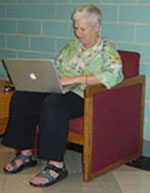
 |
In essence, engaging in multimodal composition practices opens a new "writing space" for 21 st century students. Jay Bolter, (2001, p. 12) in his theories on remediation, explains that "writing space is a material and visual field, whose properties are determined by a writing technology and the uses to which that technology is put by a culture of readers"; furthermore, each new "writing space" refashions the old (hence, "remediation"). This can be seen in the progression of "writing space(s)" from the stone to the clay tablet, to the papyrus scroll, to the codex, to the printed book, to the computer screen (Bolter, 200, p. 12). And while all multimodal composition instruction need not be inherently digital, the avenues technology affords certainly lend themselves to abundant composing possibilities. Furthermore, an integral part of Bolter's theory is its recursive nature: since every new "writing space" is a remediated version of the past, cognizance of the past is paramount. For example, if the recent "past" is represented by compositions mainly alphabetic in nature, and awareness and responsibility to that past precipitates new writing strategies and forms. Thus, when applied to multimodal composition, Bolter's theory explains how multimodal instruction can simultaneously serve traditional writing needs while at the same time pushing out and reshaping those fixated boundaries.
In explanation, the more traditional ends of composing remain integral parts of a multimodal approach. Takayoshi, Hawisher, and Selfe (2007, p. 5) write that "Conventional rhetorical principles such as audience awareness, exigence, organization, correctness, arrangement, and rhetorical appeals are necessary considerations for authors of successful audio and video compositions." Not only that, but in a nod to Bolter's remediation theory, the authors argue that "To include additional oral and visual elements in composition might be seen as a return to rhetoric's historical concerns" (Takayoshi, Hawisher, & Selfe, 2007, p. 5). This tendency for multimodal composition to "double back" to traditional concerns allows composition teachers the flexibility of focusing on those traditional elements while at the same time capitalizing on students' interests and abilities in working with multimodal formats. As Elizabeth Daly (2003, p. 37) states, students "need to be taught to write for the screen and analyze multimedia just as much as, if not more than, they need to be taught to write and analyze any specific genre in text. Generally, they have had instruction in text at the secondary level, but rarely have they received similar instruction for multimedia." Multimodal composition assignments challenge students to do both: achieve proficiency in traditional rhetorical tasks and acquire multimodal competencies, simultaneously.